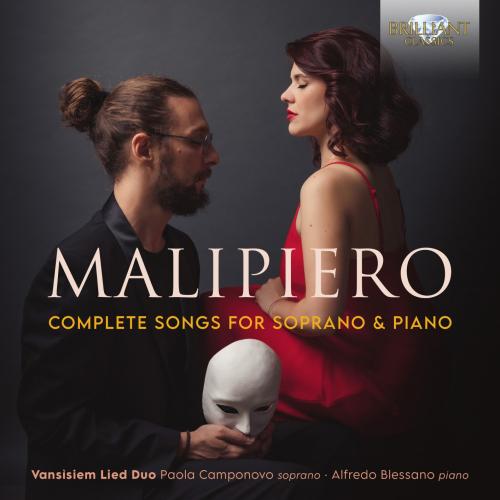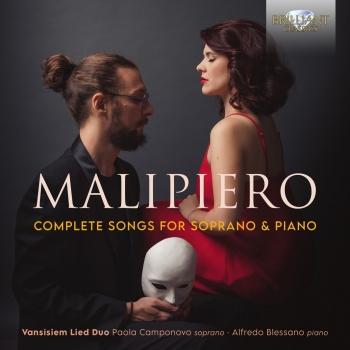
Malipiero: Complete Songs for Soprano and Piano Vansìsiem Lied Duo
Album info
Album-Release:
2021
HRA-Release:
29.10.2021
Label: Brilliant Classics
Genre: Classical
Subgenre: Vocal
Artist: Vansìsiem Lied Duo
Composer: Gian Francesco Malipiero (1882-1973)
Album including Album cover Booklet (PDF)
- Gian Francesco Malipiero (1882 - 1973): I Sonetti Delle Fate:
- 1 Malipiero: I Sonetti Delle Fate: I. Eliana 03:32
- 2 Malipiero: I Sonetti Delle Fate: II. Mirinda 02:19
- 3 Malipiero: I Sonetti Delle Fate: III. Melusina 03:15
- 4 Malipiero: I Sonetti Delle Fate: IV. Grasinda 03:12
- 5 Malipiero: I Sonetti Delle Fate: V. Morgana 02:25
- 6 Malipiero: I Sonetti Delle Fate: VI. Oriana - Oriana Infedele 06:08
- Cinq Melodies:
- 7 Malipiero: Cinq Melodies: I. Chanson Morave 03:38
- 8 Malipiero: Cinq Melodies: II. Les Yeux Couleur Du Temps 05:12
- 9 Malipiero: Cinq Melodies: III. Pégase 02:05
- 10 Malipiero: Cinq Melodies: IV. Ariette 01:13
- 11 Malipiero: Cinq Melodies: V. L'archet 05:40
- Keepsake:
- 12 Malipiero: Keepsake: I. Light 01:44
- 13 Malipiero: Keepsake: II. Song 01:20
- 14 Malipiero: Keepsake: III. Stream 02:16
- Tre Poesie Del Poliziano:
- 15 Malipiero: Tre Poesie Del Poliziano: I. Inno a Maria Nostra Donna 02:59
- 16 Malipiero: Tre Poesie Del Poliziano: II. L'eco 01:08
- 17 Malipiero: Tre Poesie Del Poliziano: III. Ballata 01:52
- Quattro Sonetti Del Burchiello:
- 18 Malipiero: Quattro Sonetti Del Burchiello: I. Cacio Stillato 02:04
- 19 Malipiero: Quattro Sonetti Del Burchiello: II. Va' in Mercato, Giorgin 01:15
- 20 Malipiero: Quattro Sonetti Del Burchiello: III. Andando a Uccellare 02:30
- 21 Malipiero: Quattro Sonetti Del Burchiello: IV. Rose Spinose 02:23
- Due Sonetti Del Berni:
- 22 Malipiero: Due Sonetti Del Berni: I. Chiome D'argento Fine 02:17
- 23 Malipiero: Due Sonetti Del Berni: II. Cancheri E Beccafichi 01:13
- Due Romanze di Domenico Gnoli:
- 24 Malipiero: Due Romanze di Domenico Gnoli: I. Fuga D'ale 02:08
- 25 Malipiero: Due Romanze di Domenico Gnoli: II. Onomasticon 02:33
- Gian Francesco Malipiero:
- 26 Malipiero: La Cavalcata Della Morte 02:31
- 27 Malipiero: Vocalizzo Per Voce Acuta 02:50
- Le Stagioni Italiche:
- 28 Malipiero: Le Stagioni Italiche: I. Lauda Per Un Morto 11:47
- 29 Malipiero: Le Stagioni Italiche: II. Canto Della Neve 04:26
- 30 Malipiero: Le Stagioni Italiche: III. Capriccio 07:31
- 31 Malipiero: Le Stagioni Italiche: IV. Ditirambo III 16:16
- Tre Canti di Filomela:
- 32 Malipiero: Tre Canti di Filomela: I. Canto Fortuna Tutto Può Che Dà Il Potere 04:30
- 33 Malipiero: Tre Canti di Filomela: II. Canto Se Tu M'ami, Se Sospiri 04:25
- 34 Malipiero: Tre Canti di Filomela: III. Canto Amore, Amore, Che Sì M'hai Ferita 06:59
- Gian Francesco Malipiero:
- 35 Malipiero: Le Sette Allegrezze D'amore 12:22
- 36 Malipiero: Mondi Celesti 06:35
- Sette Canzonette Veneziane:
- 37 Malipiero: Sette Canzonette Veneziane: I. Fa Nana Fantolin De La Madona 01:42
- 38 Malipiero: Sette Canzonette Veneziane: II. Povero Bernardon Tuto Impiagao 01:13
- 39 Malipiero: Sette Canzonette Veneziane: III. Soto Quel Sotoportego, Marieta 01:05
- 40 Malipiero: Sette Canzonette Veneziane: IV. Come I Zingari Son Tre Dì Per Liogo 01:14
- 41 Malipiero: Sette Canzonette Veneziane: V. Voi Sul Ponte Dei Pugni Darghe Un Pugno 00:41
- 42 Malipiero: Sette Canzonette Veneziane: VI. Cara, Ti Ti Xe Proprio Una Bissona 00:50
- 43 Malipiero: Sette Canzonette Veneziane: VII. Roma Xe Granda, E Xe Venezia Bela 00:52
Info for Malipiero: Complete Songs for Soprano and Piano
Belonging to the generation of Respighi but dying several decades later, Gian Francesco Malipiero (1882-1973) is a far more varied composer than listeners to his post-Romantic chamber and orchestral music would guess. This album is both the most comprehensive publication ever issued of his song output on record, and a valuable opportunity to reappraise an often under-rated 20th-century composer.
Malipiero wrote songs throughout his career, and in his late 20s found an affinity with the visionary and influential poet Gabriele d’Annunzio. Their artistic partnership began in 1909 with I sonetti delle fate, full of Wagnerian yearning in the spirit of Debussy’s incidental music to d’Annunzio’s St Sebastian play. The composer’s literary leanings and gifted word setting soon produced equally idiomatic settings of French poetry in a set of Cinq mélodies and an elliptical cycle of three poems (titled in English) by Georges Jean-Aubry, Keepsake.
With Le stagioni italiche, however, Malipiero shows himself up to date and in sympathy with the latest developments in expressionist song writing from the pens of Mahler, Schoenberg and Webern, and with an ambition to match: a 40-minute cycle of four varied texts ranging from the 15th century to Malipiero’s own day. Like much else here, the cycle has previously been recorded but never in the context of Malipiero’s other songs which help us to understand the composer’s stylistic evolution. Three years later, there followed a through-composed drama based on the ancient legend of Philomel (immortalised by Ovid in the Metamorphoses) from which Malipiero extracted a cycle of three songs. He continued to refresh his style and innovate with Le sette allegrezze d’amore from 1945, but little in his music prepares the listener for the pointilliste precision of the Sette canzonette veneziane from 1960.
Anyone with a passion for art song will want to acquaint themselves with this marvellously varied body of work, especially in the hands of the ‘Vansìsiem Lied Duo’, consisting of soprano Paola Camponovo and pianist Alfredo Blessano. Previous albums have shown them to be acutely sensitive interpreters of Rossini, Debussy and Lili Boulanger, and the French-Italian axis of Malipiero’s songs plays to their particular talents.
Gian Francesco Malipiero (1882-1973) was born in Venice on 18 March 1882 into a family of musicians. From 1898 to 1899 Malipiero studied briefly at the Vienna Conservatory; from 1899 to 1902 he studied counterpoint with Marco Enrico Bossi at the Venice Liceo Musicale e Società Benedetto Marcello and in 1908 he attended Max Bruch's classes in Berlin. Experiences which exerted a lasting influence on his creative personality were his encounter with early Italian music (Monteverdi, Frescobaldi, Merulo and others) and his stay in Paris in 1913, including his friendship with Alfredo Casella and his attendance of the première of Stravinsky’s Rite of Spring which, as he later said, woke him "from a long and dangerous lethargy."
While Malipiero's early works still manifest strong evidence of Debussy's influence, later on his harmonies move unmistakably in the direction of atonality. Malipiero's goal was giving a new direction to Italian music by fusing the traditions of Gregorian chant, Renaissance, and Baroque music with the expressive means of contemporary musical thought.
Malipiero was a member of the so-called “Generazione dell’Ottanta” composers, together with Pizzetti, Respighi, Casella and Alfano it was their intention to free Italy from the sentimentality of Tosti’s romances and the songs of Puccini and Mascagni, and draw inspiration from great poets such as D’Annunzio, developing the intellectual project of a “niche” art song that could compete with the German Lied and French Mélodie.
These 3 albums present the complete songs for soprano and piano by Malipiero, sung by the Vansìsiem Lied Duo: Paola Camponovo (soprano) and Alfred Blessano (piano). The Duo is specialised in the performance of the Italian repertoire, in particular of the Generazione dell’Ottanta. The Duo obtained many international awards, including the First Prize at Concorso Internazionale Else Respighi in Verona,¬ devoted to the Italian art song from the end of the 19th and the beginning of the 20th century.
Vansìsiem Duo:
Paola Camponovo, soprano
Alfredo Blessano, piano
No biography found.
Booklet for Malipiero: Complete Songs for Soprano and Piano












